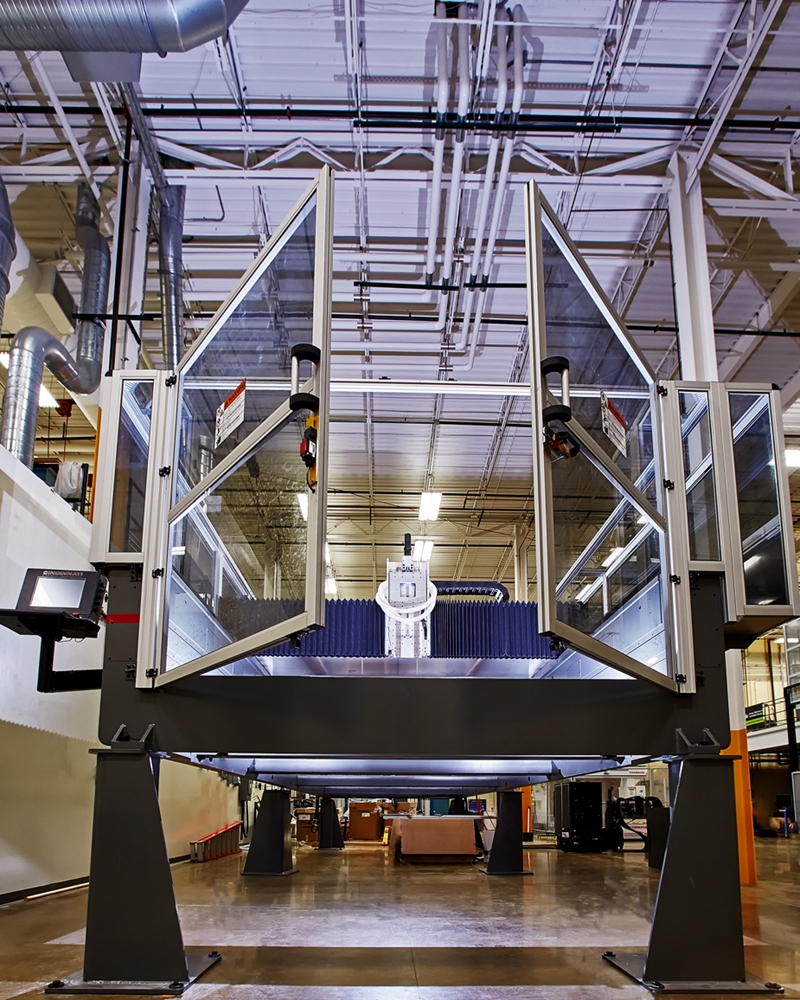 图为美国能源部在橡树岭国家实验室(ORNL)设立的制造示范工厂,现在这里拥有全球最大规模的聚合物3D打印机。ORNL与辛辛那提公司合作了一年的时间,研发出新型BAAM(大幅面增材制造)设备,辛辛那提公司的主要业务是工具制造,拥有126年的历史。
图为美国能源部在橡树岭国家实验室(ORNL)设立的制造示范工厂,现在这里拥有全球最大规模的聚合物3D打印机。ORNL与辛辛那提公司合作了一年的时间,研发出新型BAAM(大幅面增材制造)设备,辛辛那提公司的主要业务是工具制造,拥有126年的历史。 BAAM 200能够打印的最大幅面尺寸是:长20 英尺 (6.1 m),宽8 英尺 (2.4 m),高6 英尺(1.8 m)。
BAAM 200能够打印的最大幅面尺寸是:长20 英尺 (6.1 m),宽8 英尺 (2.4 m),高6 英尺(1.8 m)。 ORNL的堆叠科技工作组领导人Ryan Dehoff表示,“增材制造的一大挑战是,可能难以用传统的思维方式规划并实施部件的验收与认证工作。”
ORNL的堆叠科技工作组领导人Ryan Dehoff表示,“增材制造的一大挑战是,可能难以用传统的思维方式规划并实施部件的验收与认证工作。”
Ryan Dehoff现任美国橡树岭国家实验室(ORNL)堆叠技术工作组领导人,他致力于推进部件增材制造的研发工作,并推广多种技术的应用,包括电子束熔化成形、激光金属沉积、以及超声增材制造等。他目前着力于研究工艺技术,并通过增材制造(也称作3D打印)探索新材料,以便提升部件生产流程中的能源效率、减少材料浪费,并提高材料性能。我们近期与Dehoff进行了深入交流,了解了关于增材制造技术的更多信息。
SAE:在哪些新型应用领域有望使用增材制造?
Dehoff:汽车工业中有许多应用案例,例如使用金属粉床系统制造注塑模具。这是增材制造的一个重要应用,因为无需对使用这种技术制造的最终成品部件进行认证和质量验收,并且注塑模具部件的循环使用时间也可以极大提升,因此生产部件的成本会有所降低。因此研究人员也在尝试使用增材技术打造发动机原型,并在未来投入量产。他们试图通过优化设计来提高发动机效率、降低成本,并且增材制造技术的价值也在于,可以在铸造或量产工艺正式开始之前,详细核查设计的可行性。
SAE:目前广泛讨论的3D打印标准是什么?
Dehoff:我认为现在正在研究的标准,是将增材制造技术落实到不同产业应用中的第一个重要步骤。但我想这个技术面临的一大挑战是,或许很难用传统的思维方式去规划并实施部件的验收与认证工作。在这个领域有许多不同的机构,我也知道有许多不同的标准制定组织,他们都在推进增材制造技术的发展。有些政府标准制定部门也在增材部件认证与验收方面大有所为。我们在研究这些标准的同时,最好能够保证,除了航空航天产业之外,汽车行业和其他工业部门也能够参与到标准研究的工作中来。
SAE:大幅面增材制造技术(BAAM)的优点是什么?
Dehoff:通过我们与企业界的紧密合作,BAAM技术已经实现了相对快速的发展。辛辛那提公司(Cincinnati Inc.)正在将这项技术作为商业平台进行销售,也有其他公司正在关注大幅面增材制造系统。显然,这项技术真正改变了人们对于增材制造技术的看法。传统工艺无法完成大量材料的快速堆叠,但BAAM工艺一小时能够堆叠70 lb (32 kg)至100 lb (45 kg) 的材料。因此这种技术的材料堆叠速率是很高的,达到了以前工业界无法实现的规模。这项技术有助于彻底改变人们对于增材制造技术的认识。
SAE:您对于增材制造工艺在汽车产业中的应用有怎样的看法?
Dehoff:其实在这方面有很多进展,可能人们并没有广泛关注。但这项技术的确有望实现很多现有商业模式的彻底变革。目前大多数增材制造的应用领域比较小众化,尤其是在汽车产业。现在的发展趋势是实现增材部件的客户定制化。例如,洛克汽车公司(Local Motors)的Jay Rogers正在尝试打造一个微型工厂,你可以在这里设计你自己的汽车。同时,工具与模具产业也逐渐走向大规模定制的方向,你也可以从小规模量产阶段开始发展,当然这也是比较有特色的小众市场。最终这种技术的应用范围会越来越广。
SAE:航空航天产业是否在增材制造应用方面更为先进?
Dehoff:我个人在过去十年的产业发展中感受到的趋势是,航空航天业几乎是增材制造技术的主要驱动产业,原因是航天业在部件轻量化和高效性设计方面可以获得巨额收益。现在增材制造的部件成本在不断降低,技术可靠性越来越高,制造速度越来越快,因此许多产业都可以像汽车业一样采用这种技术。据我了解,康明斯(Cummins)正在使用增材制造技术来提高他们的发动机效率。我不清楚现在汽车的车身框架或保险杠的制造过程是否可以大规模使用3D打印技术,不过也许短期内难以实现;但涡轮增压器、水泵和发动机壳等领域的3D打印应用可能很快就可以实现,甚至比我们预计的要更快。
SAE:哪些材料可以用于增材制造技术?
Dehoff:总体来说,大多数正在研发的材料是目前用于铸造或机械成形的材料。不过我认为这种做法有点固步自封。目前行业中正在出现的整体发展趋势是,为极端苛刻的热环境设计专用的新型材料。在制造材料的过程中会产生许多热力瞬变。这些热力瞬变在传统材料上很难实现,但如果我们能够为增材技术工艺研发专用材料,我们就有望制造出更为优质的材料。在今后十年,将会出现专门为增材制造技术定制的材料。
SAE:这项技术亟待解决的挑战是什么?
Dehoff:我认为增材制造技术面临着一个特殊的挑战。由于这项技术的前景十分广阔,所以发展速度过快,你可以参阅一下(Wohlers Associates咨询公司旗下的)Terry Wohlers发布的报告,增材制造的年均复合增长率非常高。但有时候,我们的3D打印机制造速度跟不上这项技术需求的剧增速度。比如有许多打印机供应商,如果你今天跟他们订购一台打印机,可能要等一年的时间才能收到。因此现在供不应求是这个产业面临的一大挑战。
作者:Matthew Monaghan
来源:SAE《汽车工程》杂志
翻译:SAE 中国办公室
3D printing machines can't be built fast enough, ORNL expert says
As Deposition Science and Technology Group Leader at Oak Ridge National Laboratory (ORNL), Ryan Dehoff facilitates the development of additive manufacturing of components, utilizing various techniques including electron beam melting, laser metal deposition and ultrasonic additive manufacturing. He is developing processing techniques and exploring new materials via additive manufacturing (also known as 3D printing) to improve energy efficiency during component production, decrease material waste and improve material performance. We recently spoke with Dehoff to learn more.
What are some of the new applications where additive manufacturing could potentially be used?
A couple of examples I’ve seen in the automotive industry are things like utilization of metal powder bed systems to make injection mold tooling. That’s a really big application for additive manufacturing because you don’t necessarily have to certify and qualify an end-use part, but it can dramatically increase the cycle time of injection molded components and therefore lead to decreased cost of producing that component. People are also looking at utilizing additive technologies to build prototype engines that they might want to go into production in the future. So they’re trying to make those engines more efficient and more cost-effective through design optimization, and additive gives them a valuable tool to be able to go through and look at those designs prior to going into the casting or production process.
Where is the 3D printing standards discussion at currently?
The standards that are being developed, I think, are a good first step in implementation of additive into different industrial applications. But I think the big challenge with additive is it may be difficult to actually qualify and certify parts with a conventional mind-set. There are a lot of different groups; I know there are several different standards organizations and they all have efforts in additive manufacturing ongoing. Some of the government standards organizations also have some fairly large efforts going on in how to certify and qualify additive. It would be good to make sure as we go through and start trying to develop those standards that it’s not only the aerospace community that’s involved in standards development. But it’s also automotive and other industrial sectors that are involved with that development work.
What are the advantages of Big Area Additive Manufacturing (BAAM) technology?
That was a relatively rapid advance in the technology through our collaboration with industry. Cincinnati Inc. is now selling that technology as a commercial platform, and there are others that are also looking into large-area additive systems. One of the unique things that brought to the table is that it really changed the way people thought about additive. Traditionally, we don’t put down a lot of material; in the case of BAAM, we’re able to put down 70 lb (32 kg), upwards of 100 lb (45 kg) of material an hour. You can get very high deposition rates, go to very large scales that weren’t really seen across the industry before. It really helped to revolutionize people’s thought process on what additive manufacturing means.
How do you see the automotive industry embracing additive manufacturing?
There’s a lot going on behind the scenes that a lot of people aren’t necessarily talking about. Because it does have the potential to revolutionize people’s business cases. Right now, most of the additive manufacturing are niche applications, especially in the automotive industry. We have a tendency for additive parts to focus on customization. An example of the potential for customization is something like Jay Rogers from Local Motors, and what he’s trying to do is make a micro-factory where you may come in and design your car. At the same time, we see that going down into mass customization for the tool and die industry where you can start getting into very low-volume production as well, which is a little bit unique and a niche market. Eventually it may be adopted well beyond that also.
Is the aerospace industry much farther along in terms of adopting additive manufacturing?
The general trend that I’ve seen in the industry over the past decade is that aerospace seemed to be the main driver because it had huge payoffs associated with making components lighter and making components more efficient. What we’re starting to see in the additive world is that the costs of components are dropping, the technology is becoming more reliable, you can get parts fabricated faster and that’s allowing different industries to adopt additive technologies like the auto industry. There are some unique things that I know Cummins has done where they’ve been able to increase the efficiency of their engine through additive technologies. I don’t know if it’s being bulk adopted for 3D printing of car frames or bumpers; that’s probably not where we’re going to be any time soon, but on specific applications in turbochargers, water pumps and engine housings, those types of things may be a reality sooner than we think.
What are some of the materials being considered for additive?
Holistically, most of the materials that are being developed are materials that we currently use today in castings or machine forms. I think we’re limiting ourselves a little bit when we do that. What we’re starting to see a general trend in is the development of new materials specifically designed with the very harsh thermal environment during the processing condition. We get a lot of thermal transients during building. Those thermal transients can be very hard on conventional materials, but if we’re developing materials specifically in mind of being processed with additive we can actually make better material than we can today with other processes. In the next 10 years you’ll start to see customized materials specifically for additive manufacturing.
What are some of the challenges yet to be overcome?
One of the things that I see as a unique challenge in additive manufacturing is as these technologies show promise the additive manufacturing community is growing at a tremendous rate. If you look at some of the reports by Terry Wohlers [of consulting firm Wohlers Associates], there’s a huge compound annual growth associated with additive manufacturing. In some cases, we can’t actually build machines fast enough. There are a lot of companies out there that are machine vendors where if you order a machine today, you may have to wait a year until that machine arrives at your factory, there’s that much demand on the industry.
Author: Matthew Monaghan
Source: SAE Automotive Engineering Magazine
等级
打分
- 2分
- 4分
- 6分
- 8分
- 10分
平均分
